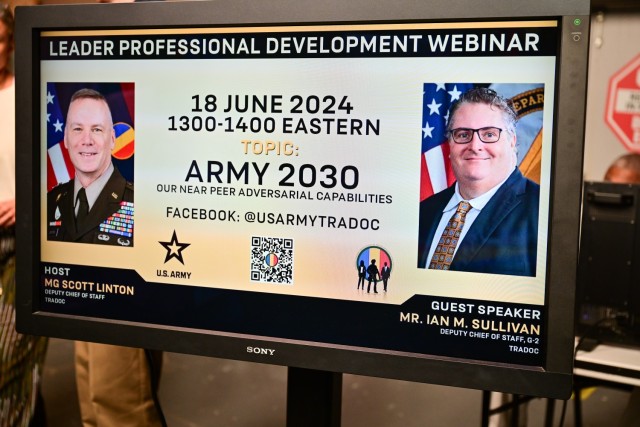
TRADOC LPD discusses the Army of 2030 and its near-peer adversaries
Nina Borgeson, TRADOC Communication Directorate
The U.S. Army Training and Doctrine Command hosted another Leader Professional Development webinar on June 18, 2024.
The webinar, featuring Maj. Gen. Scott Linton, TRADOC deputy chief of staff, and Mr. Ian Sullivan, TRADOC G-2 deputy chief of staff, focused on how TRADOC is helping the Army understand the current threat and operational environment as it shifts its focus back to large scale combat operations.
According to the National Defense Strategy, there are currently five main threats to the United States: China, as the pacing threat, Russia, as the acute threat, North Korea, Iran, and Violent Extremist Organizations. While the Army focused mainly on counter insurgency and counter terrorism in Iraq and Afghanistan for the past two decades, it is now adjusting its focus to LSCO as a reaction to shifts in the geopolitical landscape.
“We’re looking at an operational environment that is coming fast and furious, and its coming in some ways that we didn’t anticipate,” Sullivan stated. “I think the biggest one focuses on the fact that large scale combat operations are back and better than ever in some ways.”
Sullivan stated that everything that we do here at TRADOC, from preparing professional military education to training new Soldiers, starts with understanding the threat. He further explained that returning to a threat-based focus requires the Army to understand the adversary from multiple aspects, and that for TRADOC this means understanding how the adversary fights and how they are leveraging their resources and capabilities to do so.
With conflicts such as the Russian invasion of Ukraine and the conflict between Israel and HAMAS, the Army has had the opportunity to observe militaries of different sizes and capabilities to get a better understanding of what they are learning about LSCO.
“What we are seeing in all of these conflicts are some commonalities that truly reflect what contemporary conflict is in 2030 and beyond, and they are permeating the way we think and learn about training and doctrine” Sullivan claimed.
According to Sullivan, these modern conflicts have shown that it has become increasingly difficult to maneuver in modern conflict because the battlespace has become more transparent with the modernization of cybersecurity and technology.
To hear more of the conversation, watch the full LPD here…
or listen to the TRADOC Talks podcast, available wherever you listen to your podcasts.
To watch future LPD discussions, visit the TRADOC DVIDs page, TRADOC watch page, or the TRADOC Facebook page where you can submit questions to be answered throughout the webinar.
Distribution A: Approved for public release
Recent Posts
Decisive Action Training Environment: Khorathidin
Origin of the DATE Pacific Region In 2018, the…
EVOLUTION OF THE INDO-PACIFIC REGION IN THE DECISIVE ACTION TRAINING ENVIRONMENT (DATE)
This article provides background information on how the DATE Indo-Pacific…
‘Threats to Installations’ Vignettes Published to the Exercise Support Application (ESA)
The six ‘Threat to Installations’ Vignettes are products that stimulate…

